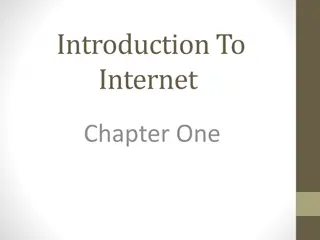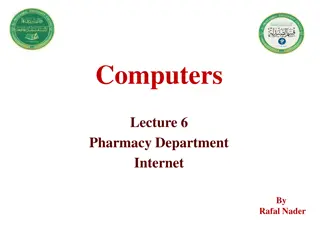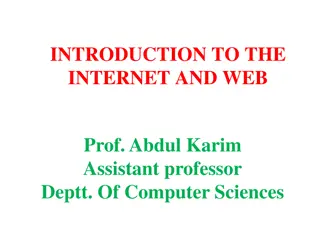Exploring the History of the Internet
Discover the origins of the internet, from the early days of hand-coded HTML websites in the mid-1990s to the development of the Web by Tim Berners-Lee. Learn about the public's growing awareness of the internet in the early 1990s and the historical connection between the telegraph and modern communication technologies. Trace the evolution from calculating machines to computers and the role of technology in World War II advancements. Dive into the fascinating journey of how the internet came to be what it is today.
Download Presentation

Please find below an Image/Link to download the presentation.
The content on the website is provided AS IS for your information and personal use only. It may not be sold, licensed, or shared on other websites without obtaining consent from the author. Download presentation by click this link. If you encounter any issues during the download, it is possible that the publisher has removed the file from their server.
E N D
Presentation Transcript
The internet A history
Internet origins Faculty early adopters established class web sites in the mid 1990s. We used hand-coded HTML, the language of the web.
Internet origins The Web was already a few years old. But slow to gain popularity. Tim Berners-Lee, inventor of the Web, was still pushing the sled uphill. People didn t understand the concept of the Web, and of non-linear information presentation.
Internet promotion The public began to notice the internet around 1993. https://www.youtube.com/watch?v=fxfhInhkvtM
Internet origins The Web was a new way to transfer information among computers. But the internet had been around a lot longer, transmitting messages by electrical pulses between machines able to read them. That concept goes back to the nineteenth century: the Victorian Internet.
Internet origins The Victorian internet was the telegraph. Samuel F.B. Morse developed a code that allowed anyone connected to a telegraph wire to send and receive messages.
Internet origins The world was connected by instantaneous communication. You could send a message to, say, London or Cairo or Melbourne as rapidly then as you can by email today. The first message was sent in 1844 by Morse from Washington to Baltimore: What hath God wrought? The first message of most computer programmers nowadays is Hello, World! We seem to have lost a bit of gravitas in the new century.
Internet origins Of course, the telegraph was not a computer. To have the internet, you need a computer. The computer is really good at arithmetic. But so was the calculating machine. As early at the 1840s, people could use machines for math. By the 1930s they were standard. But big and clunky.
Internet origins World War II troops discovered they needed better and faster ways to calculate trajectory of anti-aircraft guns. In 1944, IBM came up with a large calculator able to do that. It used instructions on punched ticker tape. Ticker tape had been around to report stock market prices since the turn of the twentieth century.
Internet origins What do you do with all that used ticker tape? Hold ticker tape parades, of course! The first ticker tape parade was New York, 1926. They look impressive, but leave an awful mess. [http://www.youtube.com/watch? v=6S8hlR0y9T4]
Internet origins In 1951, the first non-military computer, the UNIVAC, was launched by Remington Rand Corp. Problem: they were room-sized. The first integrated circuit board, or chip, was invented in 1961. Room-sized computers were located at a few major universities, shared by use of terminals.
Internet origins The big computers, of course, couldn t do what even a smartphone can today but, boy, were they impressive looking. That s what mattered in the movies and on TV. [http://www.youtube.com/watch?v=6Dz2t5EV_NA &feature=related]
Internet origins But what about the Internet? Think back to 1957. (Well, imagine back.) The United States feared the Soviet Union. Advanced Research Projects Agency, ARPA, was created as defense department think tank. If ARPA could link its computers with its subcontractors and research institutions, it could communicate more quickly.
Internet origins John Licklider, MIT, thought computers could be linked in a Galactic network, 1962. Leonard Kleinrock thought information could be sent in packages : break up information, route through several systems, reassemble it at the end.
Internet origins In 1967 several universities and laboratories drew their research together for the first internet, the ARPAnet. Kleinrock s Internet Message Processor provided the first protocol. Computers could now talk to each other.
Internet origins By 1971, 23 computers were linked to ARPAnet. It was opened to the public the next year. To build a way for computers from different networks to communicate, ARPA developed the Transmission Control Protocol/Internet Protocol, TCP/IP, in 1974. The idea was that each network could work on its own, but link to one large computer, which would provide a window to other networks, called a gateway.
Internet origins In 1974 Stanford University launched Telnet, the first commercial packet data service to transmit data over the internet. The Domain Name System (DNS) was established in 1984 to replace the original system, which assigned a separate name to each computer. It used words instead of numbers, and top-level domains such as .com, .gov, .edu and .org.
Internet origins Universities encouraged system expansion. By 1987 28,000 internet hosts existed. But it was not well known among the public, with its complicated procedures. In 1990, ARPAnet was discontinued, overtaken by the Internet. In 1991, Senator Al Gore sponsored funding for government information superhighway research.
Internet origins The problem still was the Internet s complexity. But that was soon to change. Also in 1991, the World Wide Web was released to the public. Tim Berners-Lee, an Oxford researcher working in a lab in Switzerland, devised a simplified way to use the internet.
Internet origins The idea was to use links hidden behind text to connect to other documents, making it easy to retrieve them. People were not used to finding information in this non-linear way. By 1993, only 150 websites existed in the world. Berners-Lee realized he d have to do a sales job for his new idea. www.youtube.com/watch?v=loi6PYaRqHA I would like to point out that I have something in common with Tim: we are the same age, and both graduated from Oxbridge. The similarly quite definitely ends there.
Internet origins Email, or electronic mail, uses the Internet, but with a different protocol, or way of communicating, than the web-based protocol, Hyper Text Transport Protocol (HTTP). A variety of other protocols also exist. You need a way to read Web documents. In late 1993 Marc Andressen launched the first web browser to the public, Mosaic. By 1994, it was on thousands of computers. (Firefox browser today descends from Mosaic.)
Internet origins 1994: 3,000 websites in the world. 1995: 25,000. 2001: 30 million. In 2007: 109 million. In 2013: 649 million. Brag break: Ross s website, launched July 1995, was among the first .00051 percent of web sites. But, boy, does it look old fashioned today.
Internet origins And yet it s no faster than the telegraph and Morse code developed nearly two centuries ago. http://www.youtube.com/watch?v=JOxXd 6-Orcc&feature=related























